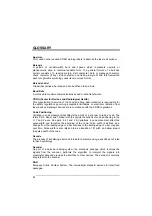
Protocol
A formal set of conventions governing the formatting and relative timing of message
exchange between two communicating systems.
Raster
The process of projecting the laser beam at varied angles spaced evenly from each
other. Typically, the mirrored rotor surfaces are angled to create multiple scan lines
instead of a single beam.
Resolution
The narrowest element dimension which can be distinguished by a particular reading
device or printed with a particular device or method.
RS232
Interface between data terminal equipment and data communication equipment
employing serial binary data interchange.
RS485
Interface that specifies the electrical characteristics of generators and receivers for
use in balanced digital multipoint systems such as on a Multidrop line.
Scanner
A device that examines a printed pattern (barcode) and either passes the
uninterpreted data to a decoder or decodes the data and passes it onto the Host
system.
Serial Port
An I/O port used to connect a scanner to your computer, identifiable by a 9-pin or 25-
pin connector.
Signal
An impulse or fluctuating electrical quantity (i.e.: a voltage or current) the variations of
which represent changes in information.
Skew
Rotation about the Y-axis. Rotational deviation from correct horizontal and vertical
orientation; may apply to single character, line or entire encoded item. See pars.
2.2.1 and 2.5.
Step-Ladder orientation
When the barcode’s bars are positioned horizontally on the product, causing them to
appear as a ladder. The ends of all bars will enter the scan window first. See par. 3.1.
Symbol
A combination of characters including start/stop and checksum characters, as
required, that form a complete scannable barcode.
34





































